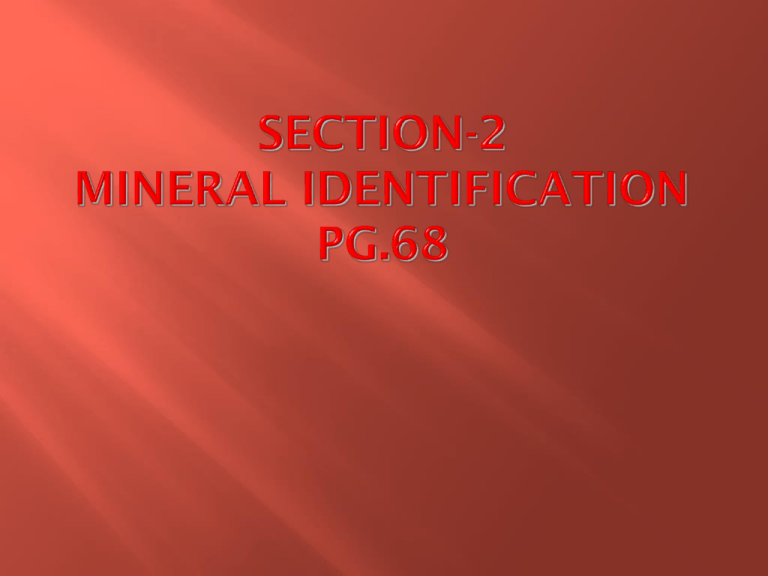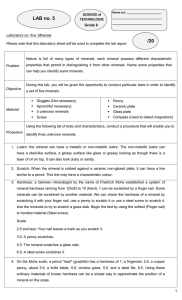Section-2 Mineral Identification pg.68
advertisement

Describe physical properties used to identify minerals. Identify minerals using physical properties such as hardness and streak. Mineral appearance Hardness Luster Specific gravity Streak Cleavage and fracture What it looks like What color is it? Which one of the following is gold? Identify by appearance. A measure of how easily a mineral can be scratched Mohs Hardness Scale Mineral Rating Testing Method Talc 1 Softest known mineral. It flakes easily when scratched by a fingernail. Gypsum Calcite 2 A fingernail can easily scratch it. 3 A fingernail cannot scratch it, but a copper penny can. Fluorite Apatite Feldspar 4 A steel knife can easily scratch it. 5 A steel knife can scratch it. 6 Cannot be scratched by a steel knife, but it can scratch window glass. Quartz Topaz Corundum Diamond 7 Can scratch steel and hard glass easily. 8 Can scratch quartz. 9 Can scratch topaz. 10 Hardest known mineral. Diamond can scratch all other substances. The way a mineral reflects light is luster. Luster is either metallic or nonmetallic. Specific gravity can be compared to density. The specific gravity of a mineral is the ratio of its mass compared with the mass of an equal volume of water. Gold has specific gravity of 19. It means gold is 19 than water. times more dense Gold is 19 times heavier, 19 times more dense than water. When a mineral is rubbed across a piece of porcelain tile a streak of powdered mineral is left behind. • • Cleavage is the way a mineral breaks along smooth, flat surfaces. Mica and calcite have cleavage. Minerals that break unevenly with rough or jagged surfaces have fracture. Quartz has fracture. quartz CLEAVAGE FRACTURE http://www.youtube.com/watch?v=VnM8ebB06MU Gems (or gemstones) are highly prized minerals because they are rare and beautiful. They are cut to sparkle. Amethyst gets its purple color from a bit of iron. Cullinan diamond Found in S. Africa in 1905 Largest uncut diamond ever found Cut into 9 main stones and 96 smaller ones Largest is called “Great Star of Africa.” Belongs to the British monarchy. Hope diamond Most famous gem Blue in color Thought to be cursed In the Smithsonian in Washington, DC Waste diamonds are used in industry as abrasives and embedded on cutting tools, such as saw blades and drill bits. Quartz crystals are used in electronics and in timepieces. They vibrate and can control frequencies. Rubies and emeralds are used in lasers. Most industrial gems are synthetic, meaning manmade. Minerals are often found in ores. Ores are minerals or rock that contains a useful substance AND can be mined at a profit. Bauxite Yields aluminum through smelting. Smelting is a process where a rock is crushed and the metals are melted out of the rock. Hematite and magnetite Yield iron used in construction, cars, and many other applications where steel is needed. Ilmenite and rutile Yield titanium Some metallic elements can dissolve in fluids. These fluids travel through cracks in rocks and form mineral deposits These are called vein minerals. Includes: gold silver copper zinc Titanium is used in Auto body parts Tennis rackets Bicycles Wheelchairs Glasses frames Replacement joints







